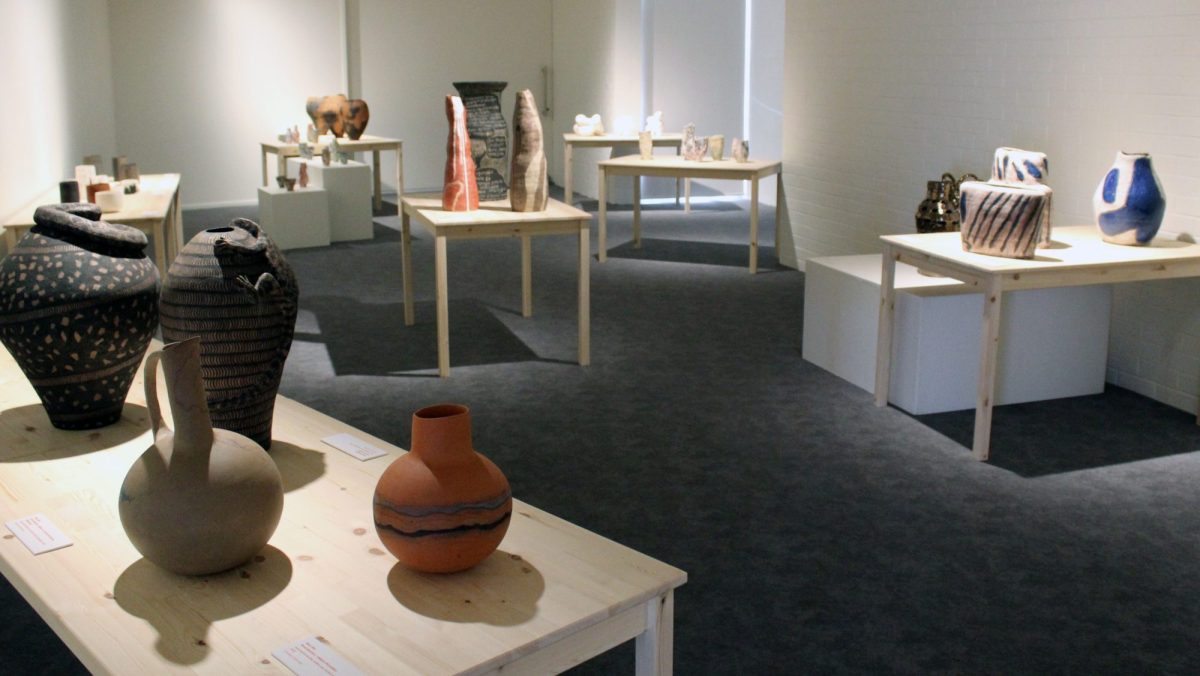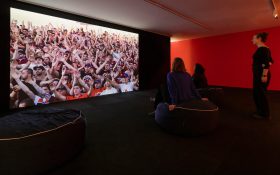Clay on Country was originally curated by Jo Foster and Neridah Stockley for the 16th Australian Ceramics Triennale in 2022. The touring of this exhibition is literally introducing the fertile ground of the Northern Territory to gallery goers around the country. There is a topography to its presentation at Logan Art Gallery. Viewers navigate the survey as an immersive landscape, which is as diverse in its forms as the cultures it may represent.
A pair of untitled vessels, inspired by termite mounds beside the Stuart Highway, pervade as organic forms. They were “hand-coiled” in buff raku trachyte by Arrernte ceramicist Alfred Lowe in 2022. There is a playfulness yet sophistication about their surfaces, which feature painted drizzles of warm-coloured underglaze accented with sgraffitoed lines. In stark aesthetic contrast, yet complementary in concept, are Australian Pastoral (1-3) (2023), which Mel Robson wheel-threw in porcelain, stoneware and terracotta.
A distinctively educational element of this exhibition lies in its encompassment of both First Nations practitioners across the Central Desert Region and an international contingent of educators and health workers drawn to work with their communities.
A lecturer for Charles Darwin University living in Arrernte, Robson appears to offer a settler perspective on the colonisation of the Northern Territory. Her fine vessels are stippled and decaled with appropriations of cadastral and pastoral maps. With a volume similar to British teacups, the scale lends them to contemplation. They invite consideration about the division of Country depicted on their surfaces.
One of the most exciting elements of the travelling show is the juxtaposition of tantalisingly tactile sculptures with engaging video and evocative frottage. Regrettably absent from this iteration is Parlanji/Putu cross sections (2021). However, “termite pavement”, clay created by watunuma or winged termites, is represented in Sally Mumford’s delicate work-on-paper Putu Frottage (2021), Wintjiya Napaltjarri’s dynamic painting Watunuma (2004) and Simon and Pantjiti Mckenzie’s video (edited by Fiona Walsh) Bush Food No.2, Mai Rungkantja, Wangunu Munu Wakati – Grain foods for grinding (1988-2022).
Whereas the latter is a documentary style video, which extrapolates other artworks in the exhibition, Antala-iperra/weather (2022) animates a Hermannsburg pot of the same title. The pair are exhibited side-by-side, literally adding another dimension to the pottery for which the Aranda women of Ntaria have become famed. They chart the seasons in Western Arrarnta, by depicting the appearance of different animals. The seasonal behaviours of the area’s human residents have also been captured.
Another part of the exhibition that is particularly pleasing to the eye and stimulating to the mind consists of vessels, sculptures and a video made by Mparntwe-based health professionals, educators and artists. There is a deliciousness about the vibrant textured surfaces of the pinched and coiled pots in Untitled (2022) made by client advocate for a First Nations social enterprise, Mikaila Rogers. Memories of cascading cake icing and candy are evoked. Social worker Maria Vanhees’ sensuous earthenware, Becoming I-II (2019), may have a contrasting yet equally appetising appeal. Investigating feelings of ‘unsettle[ment]’ and ‘vulnerability’ are the stated intentions behind the artworks.
This curious combination is visually framed by Pip McManus’ Night Vessels (2012). Projected to a monumental scale on the wall behind, the artwork explores how organic systems are being ‘pushed’ to the ‘brink of collapse’ by ‘technolog[ical]’ development. White particles of clay gently drifting in the sequence are sympathetic to Rogers’ nodular surfaces and McManus’ voluptuous forms. As the looped video progresses, a dissolving unfired figure holding a boat is shown to be the source.
This touring exhibition may be transportive for viewers, many of whom are unlikely to travel to the Central Desert. Some may be aware of the role of clay in defining human history in Asia. A primary example is the application of it by the Sumerians as the substrate for cuneiform. However, lesser known is the use of puta to process food by Australia’s First Peoples. Fewer still may be aware of the endemic storytelling practices involving drawing into the earth. From the mid-20th century, this knowledge has been captured through firing and circulated.
Read: Book review: The Honeyeaters, Jessie Tu
Clay on Country offers a history of this process. It also triumphs in making an engaging multimodal experience about a ubiquitous medium that typically has an understated presence in both domestic and public settings.
Clay on Country: Ceramics from the Central Desert will be exhibited at Logan Art Gallery until 13 July and tour to Manly Art Gallery and Museum on 30 August 2024.





